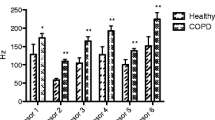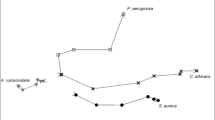Abstract
Purpose Human breath analysis is proposed with increasing frequency as a useful tool in clinical application. We performed this study to find the characteristic volatile organic compounds (VOCs) in the exhaled breath of patients with idiopathic pulmonary fibrosis (IPF) for discrimination from healthy subjects. Methods VOCs in the exhaled breath of 40 IPF patients and 55 healthy controls were measured using a multi-capillary column and ion mobility spectrometer. The patients were examined by pulmonary function tests, blood gas analysis, and serum biomarkers of interstitial pneumonia. Results We detected 85 VOC peaks in the exhaled breath of IPF patients and controls. IPF patients showed 5 significant VOC peaks; p-cymene, acetoin, isoprene, ethylbenzene, and an unknown compound. The VOC peak of p-cymene was significantly lower (p < 0.001), while the VOC peaks of acetoin, isoprene, ethylbenzene, and the unknown compound were significantly higher (p < 0.001 for all) compared with the peaks of controls. Comparing VOC peaks with clinical parameters, negative correlations with VC (r =−0.393, p = 0.013), %VC (r =−0.569, p < 0.001), FVC (r = −0.440, p = 0.004), %FVC (r =−0.539, p < 0.001), DLco (r =−0.394, p = 0.018), and %DLco (r =−0.413, p = 0.008) and a positive correlation with KL-6 (r = 0.432, p = 0.005) were found for p-cymene. Conclusion We found characteristic 5 VOCs in the exhaled breath of IPF patients. Among them, the VOC peaks of p-cymene were related to the clinical parameters of IPF. These VOCs may be useful biomarkers of IPF.


Similar content being viewed by others
References
King TE Jr, Pardo A, Selman M (2011) Idiopathic pulmonary fibrosis. The Lancet 378:1949–1961
Harari S, Caminati A (2010) IPF: new insight on pathogenesis and treatment. Allergy 65:537–553
Gross TJ, Hunninghake GW (2001) Idiopathic pulmonary fibrosis. N Engl J Med 345:517–525
Raghu G, Collard HR, Egan JJ et al (2011) An official ATS/ERS/JRS/ALAT statement: idiopathic pulmonary fibrosis: evidence-based guidelines for diagnosis and management. Am J Respir Crit Care Med 183:788–824
Rattray NJ, Hamrang Z, Trivedi DK et al (2014) Taking your breath away: metabolomics breathes life in to personalized medicine. Trends Biotechnol 32:538–548
Westhoff M, Litterst P, Maddula S et al (2010) Differentiation of chronic obstructive pulmonary disease (COPD) including lung cancer from healthy control group by breath analysis using ion mobility spectrometry. Int J Ion Mobility Spectrum 13:131–139
Van Berkel JJ, Dallinga JW, Möller GM et al (2010) A profile of volatile organic compounds in breath discriminates COPD patients from controls. Respir Med 104:557–567
Besa V, Teschler H, Kurth I et al (2015) Exhaled volatile organic compounds discriminate patients with chronic obstructive pulmonary disease from healthy subjects. Int J Chron Obstruct Pulmon Dis 10:399–406
Dragonieri S, Schot R, Mertens BJ et al (2007) An electronic nose in the discrimination of patients with asthma and controls. J Allergy Clin Immunol 120:856–862
Bunkowski A, Boedeker B, Bader S et al (2009) MCC/IMS signals in human breath related to sarcoidosis: results of a feasibility study using an automated peak finding procedure. J Breath Res 3:046001
Westhoff M, Litterst P, Freitag L et al (2007) Ion mobility spectrometry in the diagnosis of sarcoidosis: Results of a feasibility study. J Physiol Pharmacol 58:739–751
Phillips M, Cataneo RN, Condos R et al (2007) Volatile biomarkers of pulmonary tuberculosis in the breath. Tuberculosis 87:44–52
Phillips M, Basa-Dalay V, Blais J et al (2012) Point-of-care breath test for biomarkers of active pulmonary tuberculosis. Tuberculosis 92:314–320
Kamboures MA, Blake DR, Cooper DM et al (2005) Breath sulfides and pulmonary function in cystic fibrosis. Proc Natl Acad Sci USA 102:15762–15767
McGrath LT, Patrick R, Mallon P et al (2000) Breath isoprene during acute respiratory exacerbation in cystic fibrosis. Eur Respir J 16:1065–1069
Cakir Y, Métraillier L, Baumbach JI et al (2014) Signals in asbestos related diseases in human breath—preliminary results. Int J Ion Mobil Spec 17:87–94
Philips M, Cataneo RN, Cummin ARC et al (2003) Detection of lung cancer with volatile markers in the breath. Chest 123:2115–2123
Machado RF, Raskowski D, Deffenderfer O et al (2005) Detection of lung cancer by sensor array analyses of exhaled breath. Am J Respir Crit Care Med 171:1286–1291
Westhoff M, Litterst P, Freitag L et al (2009) Ion mobility spectrometry for the detection of volatile organic compounds in exhaled breath of patients with lung cancer: results of a pilot study. Thorax 64:744–748
Darwiche K, Baumbach JI, Sommerwerck U et al (2011) Bronchoscopically obtained volatile biomarkers in lung cancer. Lung 189:445–452
Kanoh S, Kobayashi H, Motoyoshi K (2005) Exhaled ethane: an in vivo biomarker of lipid peroxidation in interstitial lung diseases. Chest 128:2387–2392
Buszewski B, Grzywinski D, Ligor T et al (2013) Detection of volatile organic compounds as biomarkers in breath analysis by different analytical techniques. Bioanalysis 5: 2287–2306
Baumbach JI (2009) Ion mobility spectrometry coupled with multi-capillary columns for metabolic profiling of human breath. J Breath Res 3:034001
Hauschild AC, Schneider T, Pauling J et al (2012) Computational methods for metabolomic data analysis of ion mobility spectrometry data-reviewing the state of art. Metabolites 2: 733–755
Fink T, Baumbach JI, Kreuer S (2014) Ion mobility spectrometry in breath research. J Breath Res 8:027104
Cumeras R, Figueras E, Davis CE et al (2015) Review on ion mobility spectrometry. Part 1: current instrumentation. Analyst 140:1376–1390
Cumeras R, Figueras E, Davis CE et al (2015) Review on ion mobility spectrometry. Part 2: hyphenated methods and effects of experimental parameters. Analyst 140:1391–1410
Foster WM, Jiang L, Stetkiewicz PT et al (1996) Breath isoprene: temporal changes in respiratory output after exposure to ozone. J Appl Physiol 80:706–710
Jalali M, Zare Sakhvidi MJ, Bahrami A et al (2016) Oxidative stress biomarkers in exhaled breath of workers exposed to crystalline silica dust by SPME-GC-MS. J Res Health Sci 16:153–161
Cheresh P, Kim SJ, Tulasiram S et al (2013) Oxidative stress and pulmonary fibrosis. Biochim Biophys Acta 1832: 1028–1040
Chan PC, Haseman JK, Mahleri J et al (1998) Tumor induction in F344/N rats and B6C3F1 mice following inhalation exposure to ethylbenzene. Toxicol Lett 99:23–32
Saghir SA, Zhang F, Rick DL et al (2010) In vitro metabolism and covalent binding of ethylbenzene to microsomal protein as a possible mechanism of ethylbenzene-induced mouse lung tumorigenesis. Regul Toxicol Pharmacol 57:129–135
Saalberg Y, Wolff M (2016) VOC breath biomarkers in lung cancer. Clin Chim Acta 459:5–9
Song G, Qin T, Liu H et al (2010) Quantitative breath analysis of volatile organic compounds of lung cancer patients. Lung Cancer 67:227–231
Xie G, Chen N, Soromou LW et al (2012) p-Cymene protects mice against lipopolysaccharide-induced acute lung injury by inhibiting inflammatory cell activation. Molecules 17:8159–8173
Acknowledgements
The authors thank Mr. Yusuke Yonemura (Harada Corp, Osaka, Japan) for his technical supports. A part of the work on this paper (JIBB) has been supported by Deutsche Forschungsgemeinschaft (DFG) within the Collaborative Research Center (Sonderforschungsbereich) SFB 876 “Providing Information by Resource-Constrained Analysis”, project TB1 “Resource-Constrained Analysis of Spectrometry Data”.
Author information
Authors and Affiliations
Corresponding author
Ethics declarations
Conflict of interest
The authors have declared no conflicts of interest in connection with this article.
Ethical Approval
All procedures performed in studies involving human participants were in accordance with the ethical standards of the institutional and/or national research committee and with the 1964 Helsinki declaration and its later amendments or comparable ethical standards.
Informed Consent
Informed consent was obtained from all individual participants included in this study.
Electronic supplementary material
Below is the link to the electronic supplementary material.
Rights and permissions
About this article
Cite this article
Yamada, Yi., Yamada, G., Otsuka, M. et al. Volatile Organic Compounds in Exhaled Breath of Idiopathic Pulmonary Fibrosis for Discrimination from Healthy Subjects. Lung 195, 247–254 (2017). https://doi.org/10.1007/s00408-017-9979-3
Received:
Accepted:
Published:
Issue Date:
DOI: https://doi.org/10.1007/s00408-017-9979-3




